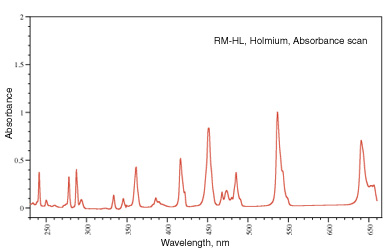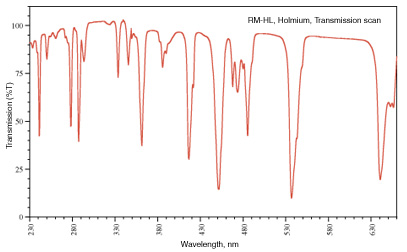
For assessing the wavelength accuracy of your spectrophotometer

| Description | Holmium oxide (4%) in perchloric acid (10%) sealed in a quartz cell |
|---|---|
| Primary Usage | Verify the wavelength scale of UV/visible spectrophotometers |
| Useable Range | 240nm to 650nm, 14 traceable absorbance peaks |
| Physical Configuration | Far UV quartz cell that has been permanently sealed by heat fusion |
| NIST Traceability | Each set is supplied with a Certificate of Analysis and NIST Traceability |
| ISO Accredited | Accredited by UKAS ISO 17025, ISO Guide34 and ISO 9001 |
Product Description
View/Download Comprehensive Data Sheet for Holmium Oxide Reference
Holmium has been used as a wavelength reference for many years and now we have extended the use by creating a filled and sealed quartz cell which allows you to verify your wavelength scale into the Ultraviolet. Holmium offers sharp, stable peaks over the range of 219nm to 650nm. Holmium perchlorate is used to assure that the wavelength scale of your instrument is within the manufacturers tolerances to the actual wavelength being measured. The use of the filled quartz cell assures that the optical configuration fo your quality control is exactly the same as for a normal analysis.
| UV Region | Visible Region | Visible Region |
|---|---|---|
| 241.0 | 333.5 | 451.1 |
| 249.9 | 345.6 | 467.8 |
| 278.2 | 361.4 | 485.2 |
| 287.1 | 385.4 | 536.5 |
| 416.1 | 640.6 |
Suggestions for Use
Holmium presents a wide range of crisply resolvable peaks which
are easily used to correlate the wavelength indicator on your spectrophotometer
to the known Holmium peaks. The first procedure should be to scan the cell over the useable
range to assure that all of the peaks can be resolved. Alter the slit width and scan
rate to produce a useable spectra. Check each peak to assure that the reading on
your spectrophotometer is within the manufacturer's tolerances for the
wavelength of your spectrophotometer. If not, get a service technician to
check and, if necessary, adjust your instrument. Holmium is measured against
an air blank.
Periodically check the spectra, at a minimum in the area where you are
doing your analysis. The periodic use of your Holmium cell will build a log
of your instrument's wavelength accuracy for use with certification and
troubleshooting should the correlation change over time.
Absorbance Scan of Holmium

Transmission Scan of Holmium

Interpertation of Results
Compare the wavelength peaks from your instrument with the expected values on the certificate supplied with the reference set. If the readings are within the expected range for your instrument then your wavelength scale is correct. If not, consult your service techincian and have the instrument evaluated
Quality program
Each time that the analysis is repeated you can compare the new results with the previous results to check for any variance. If your instrument needs service because of a change in resolution, the historical data will greatly assist the service technician.
How to Order
| Catalog Number | Description |
|---|---|
| RM-HL | Wavelength Reference Cell, Holmium Perchlorate, NIST traceable and ISO 17025 |
Download MSDS Sheet for RM-HL Reference